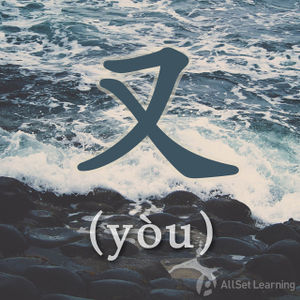Difference between revisions of "Repeated actions in the past with "you""
| (2 intermediate revisions by 2 users not shown) | |||
| Line 1: | Line 1: | ||
{{Grammar Box}} | {{Grammar Box}} | ||
| − | |||
To emphasize that an action is being repeated again and again, we can place 又 after a verb, then repeat the same verb again. | To emphasize that an action is being repeated again and again, we can place 又 after a verb, then repeat the same verb again. | ||
| − | + | == Structure == | |
In the pattern below, 又, together with a repeating verb, indicates that the speaker did something repeatedly (and probably not just twice) in the past. Note that the verb used here must be a single-syllable verb, usually a verb such as 看, 想, 问, 找, or 试. 了 is placed right after the first verb. | In the pattern below, 又, together with a repeating verb, indicates that the speaker did something repeatedly (and probably not just twice) in the past. Note that the verb used here must be a single-syllable verb, usually a verb such as 看, 想, 问, 找, or 试. 了 is placed right after the first verb. | ||
| Line 15: | Line 14: | ||
Note that "还是" or "就是" is often used to emphasize that "nothing changed" after all. | Note that "还是" or "就是" is often used to emphasize that "nothing changed" after all. | ||
| − | + | == Examples == | |
<div class="liju"> | <div class="liju"> | ||
*这 个 人 我 <strong>看</strong> 了 <em>又</em> 看,<strong>还是</strong> 觉得 我 不 认识 他。<span class="pinyin">Zhège rén wǒ kàn le <em>yòu</em> kàn, <strong>háishì</strong> juéde wǒ bù rènshi tā.</span><span class="trans">I looked at him again and again, but I still think I don't know him.</span> | *这 个 人 我 <strong>看</strong> 了 <em>又</em> 看,<strong>还是</strong> 觉得 我 不 认识 他。<span class="pinyin">Zhège rén wǒ kàn le <em>yòu</em> kàn, <strong>háishì</strong> juéde wǒ bù rènshi tā.</span><span class="trans">I looked at him again and again, but I still think I don't know him.</span> | ||
| − | * 我 <strong>想</strong> 了<em>又</em> 想,<strong>还是</strong> 觉得 不 能 这样 做 。<span class="pinyin">Wǒ xiǎng le <em>yòu</em> xiǎng, <strong>háishì</strong> juéde bù néng zhèyàng zuò.</span><span class="trans">I thought it over again and again, but I still feel I can't this.</span> | + | * 我 <strong>想</strong> 了<em>又</em> 想,<strong>还是</strong> 觉得 不 能 这样 做 。<span class="pinyin">Wǒ xiǎng le <em>yòu</em> xiǎng, <strong>háishì</strong> juéde bù néng zhèyàng zuò.</span><span class="trans">I thought it over again and again, but I still feel I can't do this.</span> |
*他 <strong>找</strong>了<em>又</em> <strong>找</strong>,<strong>还是</strong> 没 找到 他 的 钱 包。<span class="pinyin">Tā <strong>zhǎo</strong> le <em>yòu</em> <strong>zhǎo</strong>, háishì méi zhǎodào tā de qiánbāo.</span><span class="trans">He searched again and again, and still couldn't find his wallet.</span> | *他 <strong>找</strong>了<em>又</em> <strong>找</strong>,<strong>还是</strong> 没 找到 他 的 钱 包。<span class="pinyin">Tā <strong>zhǎo</strong> le <em>yòu</em> <strong>zhǎo</strong>, háishì méi zhǎodào tā de qiánbāo.</span><span class="trans">He searched again and again, and still couldn't find his wallet.</span> | ||
*他 <strong>想</strong>了<em>又</em> <strong>想</strong>,<strong>还是</strong> 不 同意。<span class="pinyin">Tā <strong>xiǎng</strong> le <em>yòu</em> <strong>xiǎng</strong>, háishì bù tóngyì.</span><span class="trans">He thought it over again and again, and he still disagrees.</span> | *他 <strong>想</strong>了<em>又</em> <strong>想</strong>,<strong>还是</strong> 不 同意。<span class="pinyin">Tā <strong>xiǎng</strong> le <em>yòu</em> <strong>xiǎng</strong>, háishì bù tóngyì.</span><span class="trans">He thought it over again and again, and he still disagrees.</span> | ||
| Line 38: | Line 37: | ||
*[[Comparing "zai" and "you"]] | *[[Comparing "zai" and "you"]] | ||
*[[Emphasizing negation with "you"]] | *[[Emphasizing negation with "you"]] | ||
| − | |||
| − | |||
| − | |||
[[Category:B2 grammar points]] | [[Category:B2 grammar points]] | ||
Latest revision as of 09:37, 14 January 2021
-
Level
-
Similar to
-
Used for
-
Keywords
To emphasize that an action is being repeated again and again, we can place 又 after a verb, then repeat the same verb again.
Structure
In the pattern below, 又, together with a repeating verb, indicates that the speaker did something repeatedly (and probably not just twice) in the past. Note that the verb used here must be a single-syllable verb, usually a verb such as 看, 想, 问, 找, or 试. 了 is placed right after the first verb.
Subj. + Verb + 了 + 又 + Verb, (还是 / 就是) ……
Note that "还是" or "就是" is often used to emphasize that "nothing changed" after all.
Examples
- 这 个 人 我 看 了 又 看,还是 觉得 我 不 认识 他。I looked at him again and again, but I still think I don't know him.
- 我 想 了又 想,还是 觉得 不 能 这样 做 。I thought it over again and again, but I still feel I can't do this.
- 他 找了又 找,还是 没 找到 他 的 钱 包。He searched again and again, and still couldn't find his wallet.
- 他 想了又 想,还是 不 同意。He thought it over again and again, and he still disagrees.
- 我们 问 了 又 问,她 就是 不 说。We asked again and again, but she wouldn't tell us.
- 他 试 了 又 试,就是 打 不 开 门。He tried again and again, but he still couldn't open the door.
- 我 想 了 又 尝,还是 觉得 这些 菜 坏 了。I tasted it again and again, but I still think the food has gone bad.
- 他 闻 了 又 闻,还是 什么 都 没 闻到。He sniffed again and again, but he still didn't smell anything.
- 这 个 方案 改了又 改,终于 通过 了。This plan was changed again and again, and finally it was approved.
- 这 件 衣服 妈妈 洗 了 又 洗,终于 洗 干净 了。Mother washed this clothing again and again, and it's finally clean.



